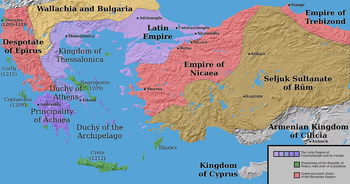Partitio terrarum imperii Romaniae
 | |
| Context | Sack of Constantinople during the Fourth Crusade |
|---|---|
| Signed | 1204 |
| Location |
Constantinople, Latin Empire (now Istanbul, Turkey) |
| Signatories | |
The Partitio terrarum imperii Romaniae (Latin for "partition of the lands of the empire of Romania[1] [Byzantine Empire]) was a treaty signed amongst the crusaders after the sack of the Byzantine capital, Constantinople, by the Fourth Crusade in 1204. It established the Latin Empire and arranged the nominal partition of the Byzantine territory among the participants of the Crusade, with the Republic of Venice being the greatest titular beneficiary. However, because the crusaders did not in fact control most of the Empire, with local Byzantine Greek nobles establishing the Byzantine successor kingdoms (Empire of Nicaea, Empire of Trebizond, Despot of Epirus), most of the crusaders' declared division of the Empire amongst themselves could never be implemented.
Provisions
The treaty, which was promulgated either in late September / early October 1204 or (according to Nikolaos Oikonomides) immediately after the sack in April–May 1204, was drafted by a 24-man committee consisting of 12 Venetians and 12 representatives of the other Crusader leaders. It gave the Latin Emperor direct control of one fourth of the Byzantine territory, to Venice three eighths – including three eighths of the city of Constantinople, with Hagia Sophia – and the remaining three eighths were apportioned among the other Crusader chiefs. Through this division, Venice became the chief power in Latin Romania, and the effective power behind the Latin Empire, a fact clearly illustrated by the lofty title its Doge acquired: Dominator quartae et dimidiae partis totius Romaniae ("Lord of a quarter and a half quarter of all of Romania").
Effects
The Partitio Romaniae initiated the period of the history of Greece known as Frankokratia or Latinokratia ("Frankish/Latin rule"), where Catholic West European nobles, mostly from France and Italy, established states on former Byzantine territory and ruled over the mostly Orthodox native Byzantine Greeks. The provisions of the Partitio Romaniae were not fully carried out, with most of the Byzantine realm falling into the hands not of the crusaders who had sacked the capital but of the local Byzantine Greek nobles, who established the Despotate of Epirus, Empire of Nicaea and Empire of Trebizond Byzantine successor states, as well as due to squabbles among the Crusaders themselves. The rump Latin Empire itself, consisting of the area surrounding Constantinople, Thessaloniki, and the Sea of Marmara was also drawn into a disastrous conflict with the powerful Second Bulgarian Empire.
Importance as a historical source
As the division was based on now lost documents and tax registers from the Byzantine imperial chancery, the Partitio Romaniae is a valuable document for the administrative divisions (episkepseis) and estates of the various Byzantine magnate families ca. 1203, as well as the areas still controlled by the Byzantine central government at the time.
Sources
- Alexander Kazhdan, ed. (1991). Oxford Dictionary of Byzantium. Oxford University Press. pp. 1591–92. ISBN 978-0-19-504652-6.
References
- ↑ On the meaning of Romania, an ambiguous term, see R.L. Wolff, "Romania: The Latin Empire of Constantinople". In: Speculum, 23 (1948), pp. 1-34.
| ||||||||||
| ||||||||||||||||||
